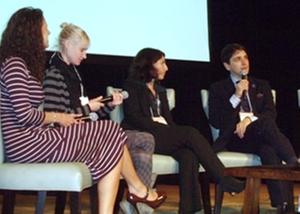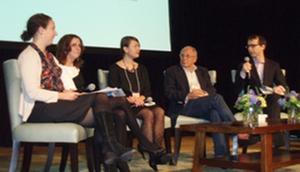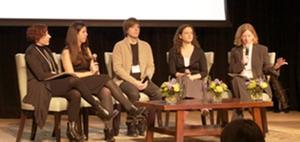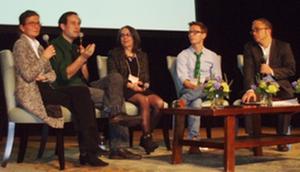The theme of the Publishing Perspectives day-long conference held on November 28 was "YA: What's Next?" But it could as easily have been called: "YA: Who's Buying it?"

|
|
| Scholastic's Stacy Lellos, Larissa Faw of Youth Markets Alert, Mara Anastas from S&S and Ed Nawotka of Publishing Perspectives, moderator for "Digital Marketing for YA: Reaching Readers Beyond the Bookstore." | |
Bowker's Carl Kulo presented highlights from the biannual study "Understanding the Children's Book Consumer in the Digital Age." Kulo was quick to point out that the term "YA" in the study refers to "the genre YA, not young adults as a demographic." In other words, Kulo explained, "Large portions of readers of YA were not teens." In fact, the study showed 55% of buyers of what publishers call "YA" are 18 or older; the largest segment is 30-44 years old. Of all YA books sold, 48% are purchased in a store; 36% are sold online. Most buy due to a personal recommendation (29%); 10% buy because of an in-store display; another 10% buy from the bestseller lists; and only 3% were sold due to social networks like Facebook and Twitter (19% of sales were attributed to "other").

|
|
|
Aimee Friedman (Scholastic), author Beth Kephart, Elizabeth Perle (Huffington Post), Dan Weiss (St. Martin's) and Andrew Losowsky, books editor for Huffington Post and moderator for "Drawing the Line: What's the Difference Between a YA and an Adult Book?" |
|
So how do you get to teens? Scholastic's Stacy Lellos said, "You have to look for kids wherever they are." For Mara Anastas of Simon & Schuster, that meant partnering with Mobile Commons for texting campaigns. S&S's Pulse It teen online community now boasts 60,000 members. First they mailed out ARCs, then hosted an online discussion of the books. Lellos has used Good Reads, Facebook and Figment to spread the word. But, Lellos stressed, "It all starts with a good book."
How do publishers decide to label a title an adult book or a young adult book? "It's a marketing challenge, not an editorial challenge," argued St. Martin's Dan Weiss, who was the first (but not the last) to introduce the term "New Adult" into the day's discussion. Author and Scholastic editor Aimee Friedman agreed; she believes that authors cannot talk down to kids, quoting E.B. White: "Anybody who shifts gears when he writes for children is likely to wind up stripping his gears." Friedman cited Lev Grossman's recent New York Times article about adult members of his book club who read YA books, and his claim that the best YA books are defined by a precision of language. Novelist Beth Kephart (Small Damages) described YA books as possessing an "urgency" that stands in contrast to a book such as The Age of Miracles, which is shaped by the distance of its narrator. Kephart also attributed the blurring of lines to "an era of intense parenting," in which mother-daughter book clubs thrive.

|
|
| Charlie Schroder (Charlie & Co.), Regina Weiner (Metaverse Mod Squad), Jake Katz (YPulse), Julie Hochheiser Ilkovich (Alloy) with Shelf Awareness's Jennifer M. Brown, moderator for "Reaching Teens: Thinking Out of the Box." | |
Charlie Schroder, founder of Charlie & Co., underscored Kephart's point as she described how mothers and daughters shop together at stores like Forever 21. Jake Katz of YPulse said 86% of kids now say their parents are "like a best friend." Alloy's Julie Hochheiser Ilkovich described this generation as "self-involved but also socially aware and entrepreneurial." They are also drawn to an "immersive" experience, said Regina Weiner (Metaverse Mod Squad), that allows kids to enter the story through books, games and films. Schroder noted that, to today's teens, "curation is as valuable as co-creation." If you create something of value, that's one thing, but if you discover that thing of value and spread the word, that's just as valuable. So, Katz suggested, you want them as consumers at the front end of the process, but then to also leverage them as curators; it's about "inspiration not feedback."
 |
|
| Doris Janhsen (Oetinger Verlag), author and Scholastic editor David Levithan, Francine Lucidon (Voracious Reader Bookstore), author Eliot Schrefer with Dennis Abrams of Publishing Perspectives, moderator for "YA: What's Next?" | |
Regarding labeling, Doris Janhsen of Germany's Oetinger Verlag dismissed the phrase "new adult" as an "absurd term." Scholastic's David Levithan chimed in, "In Judaism, we call them 13-year-olds." He added, "New adult is basically what we used to call 'chick lit.' " National Book Award finalist Eliot Schrefer (Endangered) said the category "promises the pleasures of YA fiction without restrictions of content." Francine Lucidon of the Voracious Reader Bookstore in Larchmont, N.Y., believes that YAs are always "looking for ways to connect to the world." She handsells Never Fall Down as "the real Hunger Games." Lucidon echoed Daniel Handler: "Perhaps we're asking all the wrong questions. What's happening right now?" Levithan, editor of The Hunger Games and The 39 Clues, followed up on her thought: "You don't know what's next, and that's the fun thing."
In many ways, this closing panel's discussion brought the audience back full circle to the themes of Beth Kephart's opening keynote. "The YA books of the future will give rise and shape to the generation whose job it has become to fix the mess we're in," said Kephart. Her words were a call to action for an audience who has the power to shape that future. She closed, "I'm thinking that politics aren't working so well, and that our planet and our children need us, and that our stories, meticulously made, can still be the cure." --Jennifer M. Brown

